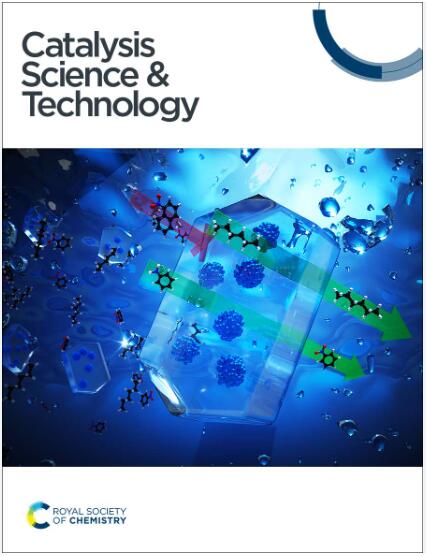Insight into the key factors governing the catalytic activity and stability of Ni/ZnO catalysts in CO2 hydrogenation†
IF 4.4
3区 化学
Q2 CHEMISTRY, PHYSICAL
引用次数: 0
Abstract
The requirements for industrial catalysts are not only high efficiency but also excellent stability. Therefore, understanding the crucial factors governing the catalytic performance and long-term stability is fundamental yet challenging due to the structural complexity of heterogeneous catalysts. Herein, ZnO-supported Ni catalysts with different ZnO morphologies were used for CO2 hydrogenation. The results revealed that catalytic activity and stability were strongly related to weak basic sites and Ni–ZnO interactions, respectively. The Ni/r-ZnO (nanorod) catalyst, which possessed a higher amount of weak basic sites responsible for the adsorption and activation of CO2, exhibited better catalytic activity. Nonetheless, r-ZnO, predominantly exposing nonpolar facets, was not conducive to Ni–r-ZnO interactions, which led to the agglomeration of supported Ni species during CO2 hydrogenation and was the primary cause of the deactivation of the Ni/r-ZnO catalyst. Meanwhile, carbon deposition could be another minor factor affecting catalytic stability. Kinetic and in situ DRIFTS spectroscopy results demonstrated that the reaction proceeded through an H2-assisted associated mechanism, with the adsorption and activation of CO2 as the rate-determining step. These results not only deepen the fundamental understanding of Ni-/ZnO-catalyzed CO2 hydrogenation but also provide potential insights for developing highly active and stable catalysts for CO2 hydrogenation.
Ni/ZnO催化剂在CO2加氢过程中催化活性和稳定性的关键因素研究
工业催化剂不仅要求效率高,而且要求稳定性好。因此,了解控制催化性能和长期稳定性的关键因素是基本的,但由于非均相催化剂的结构复杂性,这是具有挑战性的。本文采用不同ZnO形貌的ZnO负载型Ni催化剂进行CO2加氢。结果表明,催化活性和稳定性分别与弱碱性位点和Ni-ZnO相互作用密切相关。Ni/r-ZnO(纳米棒)催化剂具有较多的吸附和活化CO2的弱碱位点,表现出较好的催化活性。然而,r-ZnO主要暴露非极性面,不利于Ni - r-ZnO相互作用,导致CO2加氢过程中负载Ni物种团聚,是Ni/r-ZnO催化剂失活的主要原因。同时,碳沉积可能是影响催化稳定性的另一个次要因素。动力学和原位漂移光谱结果表明,该反应是通过h2辅助的相关机制进行的,以CO2的吸附和活化为速率决定步骤。这些结果不仅加深了对Ni / zno催化CO2加氢的基本认识,而且为开发高活性和稳定的CO2加氢催化剂提供了潜在的见解。
本文章由计算机程序翻译,如有差异,请以英文原文为准。
求助全文
约1分钟内获得全文
求助全文
来源期刊

Catalysis Science & Technology
CHEMISTRY, PHYSICAL-
CiteScore
8.70
自引率
6.00%
发文量
587
审稿时长
1.5 months
期刊介绍:
A multidisciplinary journal focusing on cutting edge research across all fundamental science and technological aspects of catalysis.
Editor-in-chief: Bert Weckhuysen
Impact factor: 5.0
Time to first decision (peer reviewed only): 31 days
 求助内容:
求助内容: 应助结果提醒方式:
应助结果提醒方式:


